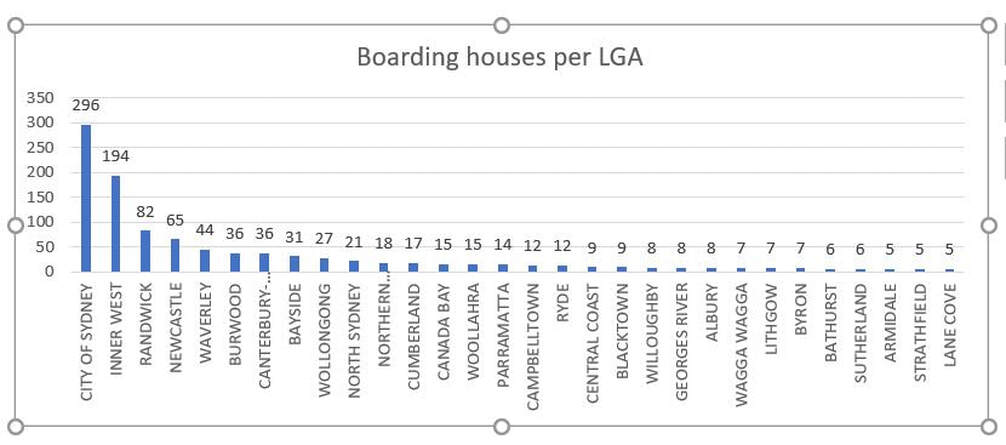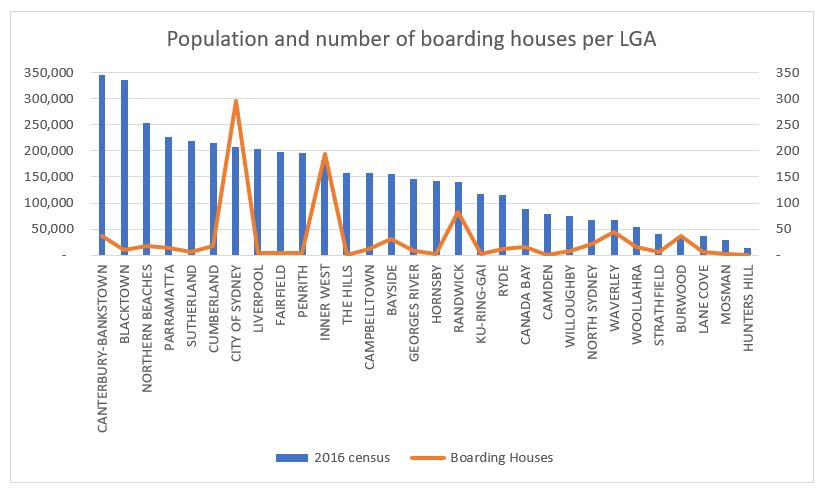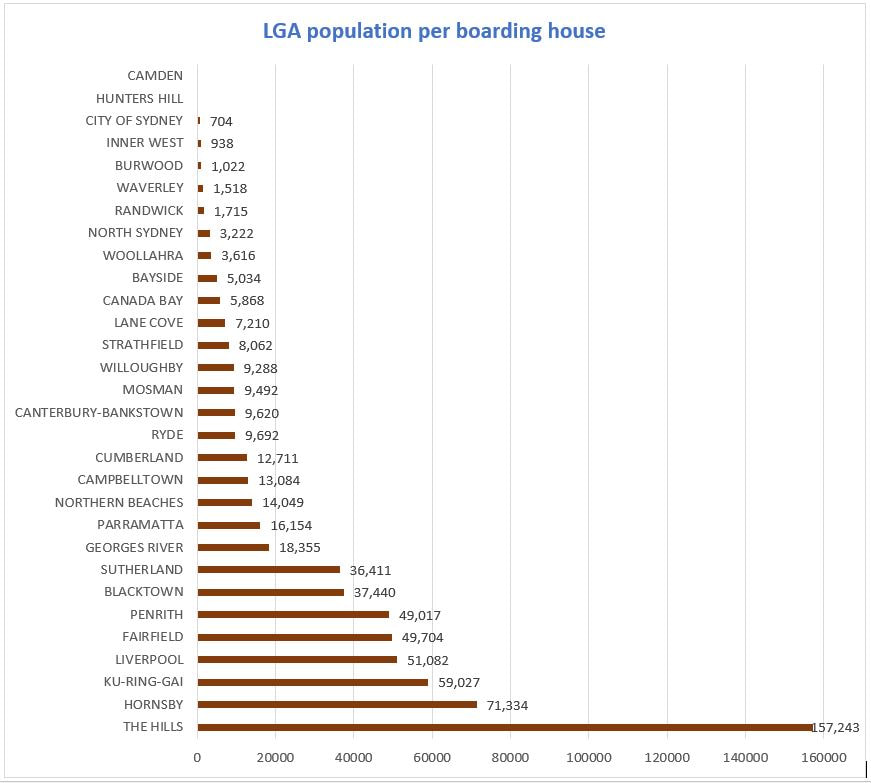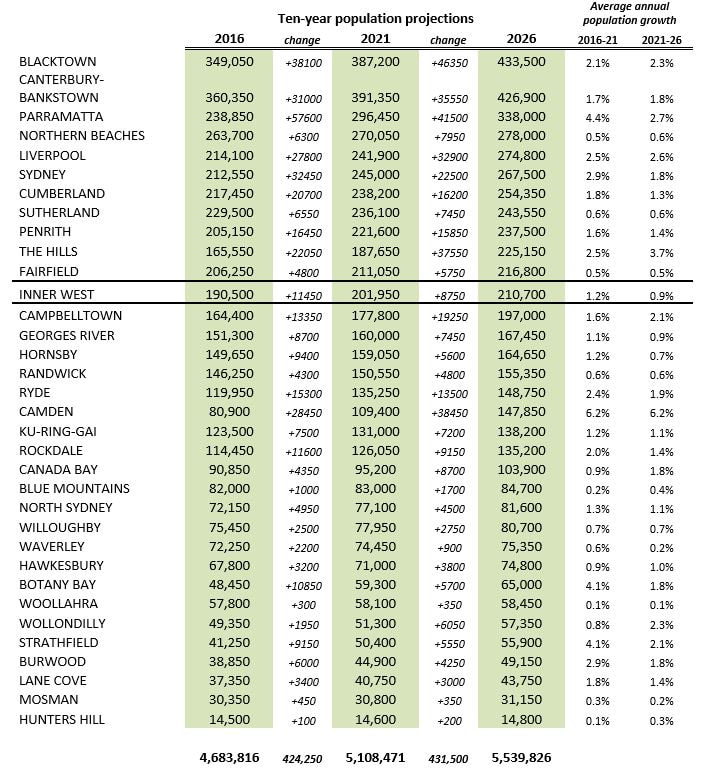387 and 389 illawarra road
da201900287 demolition application
More Marrickville boarding houses?
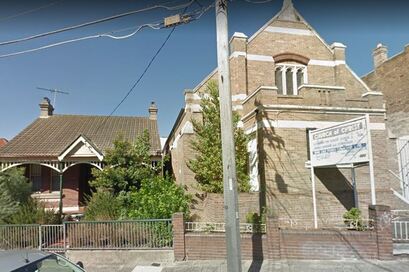
Last year in the NSW Land and Environment Court permission was given to the Greek Orthodox Church of Marrickville to demolish a building referred to as the ‘SES building’ in Livingstone Road. It is to be replaced by a 24-room boarding house to accommodate 48 people. The Church of Christ has submitted a Development Application to demolish its church and adjoining heritage home at 387 – 389 Illawarra Road to build a five-storey boarding house plus ground floor retail. I wanted to work out whether the destruction of heritage properties in Marrickville could be justified by balancing the loss against the creation of affordable and social housing.
I wanted data about how many boarding houses were currently in Marrickville, Sydney and NSW. I wanted to measure volumes against the population in each Local Government Area (LGA) to see whether Marrickville is contributing more or less than other LGAs across Sydney.
I gathered the available data about boarding houses in NSW from the Department of Fair Trading and started digging. I was very surprised to read that as at September 2019 there are 1088 boarding houses in NSW. I wanted to map the distribution of them and see where population was projected to increase, in order to determine whether boarding houses would meet a long-term need, or whether they were simply a new development fad. Are they providing cheap housing options for the marginalised or are they providing a co-living option for single people?
For data about population I used the 2016 census.
Distribution of boarding houses across NSW
The following graph shows the distribution of boarding houses by LGA across NSW. I have removed the data for those Council areas with less than 5 boarding houses for now.
Distribution of boarding houses across NSW
The following graph shows the distribution of boarding houses by LGA across NSW. I have removed the data for those Council areas with less than 5 boarding houses for now.
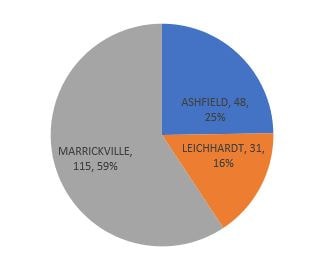
I wanted to see the breakdown of the Inner West under the pre-amalgamation LGAs. This chart shows the old LGA name, the number of boarding houses and the percentage of the Inner West total.
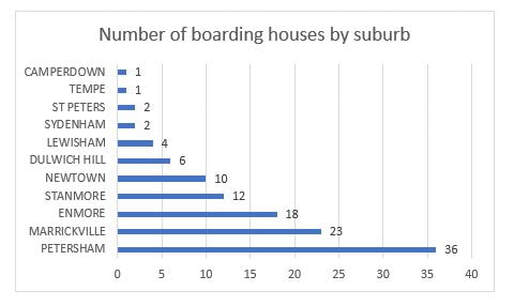
And what about the suburb of Marrickville? Let’s breakdown the 115 boarding houses in the old Marrickville LGA a bit further.
The Inner West and Marrickville were towards the top of the pack in terms of number of boarding houses currently operating.
That led me to wonder about the rest of Sydney. Is the housing crisis an Inner West problem or a Sydney wide problem? Is the Inner West compensating for other Sydney LGAs that aren’t contributing low-cost housing options? And what about the rest of NSW?
The Inner West and Marrickville were towards the top of the pack in terms of number of boarding houses currently operating.
That led me to wonder about the rest of Sydney. Is the housing crisis an Inner West problem or a Sydney wide problem? Is the Inner West compensating for other Sydney LGAs that aren’t contributing low-cost housing options? And what about the rest of NSW?
Spread of boarding houses across population centres
I wanted to measure the number of boarding houses against the population sizes they supported. I surmised that the greater the population, the greater the affordable and social housing need. I compared the 2016 population data to the number of boarding houses. And threw in a ratio for good measure. This would have been more informative if I could have included some capacity measures by including the number of beds in the boarding houses, but the call to the Department of Fair Trading wasn’t going my way.
I wanted to measure the number of boarding houses against the population sizes they supported. I surmised that the greater the population, the greater the affordable and social housing need. I compared the 2016 population data to the number of boarding houses. And threw in a ratio for good measure. This would have been more informative if I could have included some capacity measures by including the number of beds in the boarding houses, but the call to the Department of Fair Trading wasn’t going my way.

Firstly I split up the data by area: Sydney metropolitan, Sydney surrounds and regional NSW.
The Sydney surrounds (Central Coast, Blue Mountains, Hawkesbury and Wollondilly) statistic surprised me. With population spreading outwards from Sydney, especially to the Central Coast, 14 boarding houses in a population area of more than half a million people sounded deficient. I wondered whether the popularity of boarding houses might just be a Sydney phenomenon, and in areas where land values were lower, other affordable housing options were available.

Here’s the breakdown of the Sydney surrounds area. The Central Coast LGA is the third largest in NSW.
Focussing on Sydney, I wanted to measure the number of boarding houses per LGA against its population. The following graph shows the population per LGA in blue and the number of boarding houses in orange.
I have new found respect for our neighbours across the river in Canterbury-Bankstown. After their amalgamation they have a population of nearly 350,000.
At first glance some LGAs with high population seemed to have very few boarding houses so I levelled the playing field with a ratio. The lower the ratio, the better the contribution to affordable housing in the LGA. I stared with envy at the LGAs that so obviously avoided amalgamation but tried not to dwell on it.
At first glance some LGAs with high population seemed to have very few boarding houses so I levelled the playing field with a ratio. The lower the ratio, the better the contribution to affordable housing in the LGA. I stared with envy at the LGAs that so obviously avoided amalgamation but tried not to dwell on it.
Neither Hunters Hill or Camden provide any boarding house accommodation. The Hills has a single boarding house for its population of nearly 160,000. Blacktown has a similar population to Canterbury Bankstown but provides little in the way of boarding house accommodation. As with the Central Coast I wondered whether this was because of a disparity in land values, and therefore other housing options could be provided in that LGA. The same would apply in Penrith, Fairfield and Liverpool. It’s a question I can’t answer but is worth pondering. Both the City of Sydney and the Inner West cater well for affordable housing options for their population (assuming boarding house accommodation is classified as affordable).
I was looking to see whether the population of the Inner West was predicted to boom and therefore we would need to start preparing for an influx of new residents.
This is the full dataset of forecast population growth by LGA in the Sydney metropolitan region and is for die-hard data lovers only. Everyone else should skip through it, butI have highlighted the Inner West projections for you.
This is the full dataset of forecast population growth by LGA in the Sydney metropolitan region and is for die-hard data lovers only. Everyone else should skip through it, butI have highlighted the Inner West projections for you.
The Inner West is expecting to see less than 20,000 extra residents across this ten-year period, a growth rate of around 1%. Large growth is expected to be seen in Parramatta and Camden, with a short-term growth spurt seen in Strathfield and Botany Bay.
Style of accommodation required
I wanted to find out whether boarding house accommodation would provide a long-term housing solution for the Inner West as it experienced minor growth over the nest ten years. Whether boarding houses will help meet the demand is dependent on the type of households that will be adopting that type of accommodation. The Department of Planning and Environment provided data about the current size of households around the Sydney area and how they are projected to grow, or shrink.
Style of accommodation required
I wanted to find out whether boarding house accommodation would provide a long-term housing solution for the Inner West as it experienced minor growth over the nest ten years. Whether boarding houses will help meet the demand is dependent on the type of households that will be adopting that type of accommodation. The Department of Planning and Environment provided data about the current size of households around the Sydney area and how they are projected to grow, or shrink.
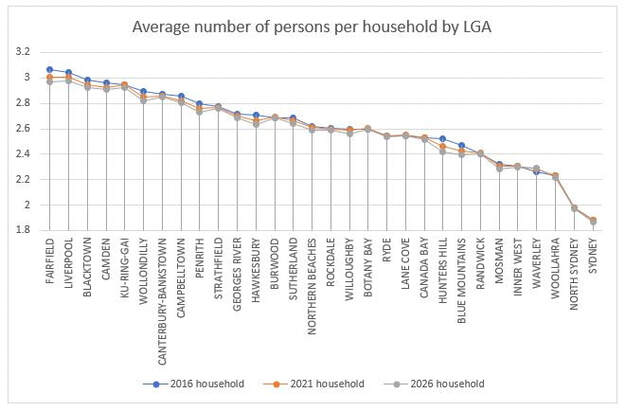
In all Sydney LGAs, household size is expected to either remain stable or reduce. There is no part of Sydney where households are expected to increase in size. But will they reduce enough to create increased demand for boarding house style accommodation? Not according to the data. There are only two LGAs where the average number of people in a household is less than 2: City of Sydney and North Sydney. The City of Sydney already supports low-cost accommodation with 296 boarding houses. North Sydney has 21. All other LGAs show an average household of at least two people. The Inner West has an average household of 2.3 and a stable predicted demography. The principal style of accommodation that the Inner West will require in the next ten years should be suitable for two to three person households.
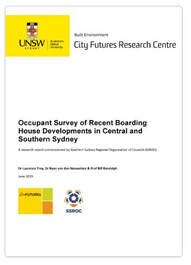
Do boarding houses meet a social need?
Results of a survey of boarding houses conducted by the City Futures Research Centre at UNSW were published in June 2019. It states that the purpose of boarding houses, according to the Department of Planning and Environment is to provide accommodation that is accessible to tenants who could find it difficult to obtain mainstream rental accommodation, reduce social housing waitlists and provide a market-based form of transitional housing. The survey was distributed to boarding houses in the Southern Sydney Regional Organisation of Councils (SSROC) which includes the Inner West LGA. Purpose built student accommodation houses were excluded. This is a summary of their findings:
This style of accommodation was found to be not suitable for those in need of affordable housing, those on social housing waitlists and those excluded from mainstream rental markets or seeking transitional housing. They were labelled as ‘micro-apartments’ by City Futures.
The need that is being met is for small, modern, well appointed and well situated apartments.
My own research indicated that there are only 22 assisted boarding houses in NSW and six of those are in Lithgow with two in the Inner West. They provide accommodation for people with additional needs due to a permanent disability, a mental illness or age related frailty.
Results of a survey of boarding houses conducted by the City Futures Research Centre at UNSW were published in June 2019. It states that the purpose of boarding houses, according to the Department of Planning and Environment is to provide accommodation that is accessible to tenants who could find it difficult to obtain mainstream rental accommodation, reduce social housing waitlists and provide a market-based form of transitional housing. The survey was distributed to boarding houses in the Southern Sydney Regional Organisation of Councils (SSROC) which includes the Inner West LGA. Purpose built student accommodation houses were excluded. This is a summary of their findings:
- Few new boarding houses presented as ‘traditional’ boarding house accommodation.
- Occupants were close in profile to typical renters than traditional boarding house occupants or those on social housing waitlists.
- Occupants were overwhelmingly employed or undertaking tertiary studies (91%)
- Two thirds already held a tertiary qualification.
- 65% were born overseas.
- 63% were under 35 years of age.
- One third of occupants owned a car.
- 74% were single tenants, 19% lived with a partner.
- 86% were rented out under formal tenancy agreements, not as ‘lodgings’.
- New boarding houses did not provide a significantly more affordable housing option. 64% of residents earned less than $800 per week and 90% of those were paying more than a third of their income in rent and were classified as in rental stress.
This style of accommodation was found to be not suitable for those in need of affordable housing, those on social housing waitlists and those excluded from mainstream rental markets or seeking transitional housing. They were labelled as ‘micro-apartments’ by City Futures.
The need that is being met is for small, modern, well appointed and well situated apartments.
My own research indicated that there are only 22 assisted boarding houses in NSW and six of those are in Lithgow with two in the Inner West. They provide accommodation for people with additional needs due to a permanent disability, a mental illness or age related frailty.
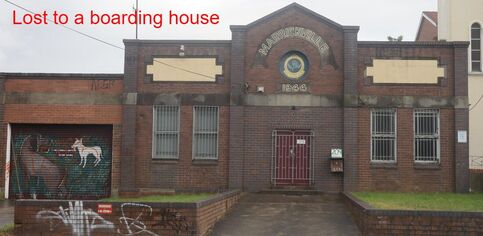
More boarding houses for Marrickville?
The case for building new boarding houses in Marrickville is weak. They provide housing for mainly single and some double person households. Their claims to provide low-cost housing are spurious based on evidence from the new boarding houses across the SSROC. Ten-year population projections show limited growth in the Inner West with an average household size that can’t be homed in boarding house style accommodation. As far as social housing is concerned, the Inner West provides 194 boarding houses, a ratio of one boarding house per less than 1,000 people in the LGA. This is second to only the City of Sydney. Marrickville is contributing well above what could be expected from an LGA with a population of 182,000. All 23 boarding houses in the suburb of Marrickville are traditional style boarding houses that better meet the needs of the marginalised and dispossessed.
When you overlay this argument with the destruction of heritage homes, it doesn’t stack up. Part of the reason why people flock to Marrickville is because of its character and quirkiness that create the special vibe that is Marrickville. The sanitisation of the suburb is incongruous with its social value. Worse than that, it is destroying it.
Copyright © 2019 Marrickville Unearthed. All rights reserved.
The case for building new boarding houses in Marrickville is weak. They provide housing for mainly single and some double person households. Their claims to provide low-cost housing are spurious based on evidence from the new boarding houses across the SSROC. Ten-year population projections show limited growth in the Inner West with an average household size that can’t be homed in boarding house style accommodation. As far as social housing is concerned, the Inner West provides 194 boarding houses, a ratio of one boarding house per less than 1,000 people in the LGA. This is second to only the City of Sydney. Marrickville is contributing well above what could be expected from an LGA with a population of 182,000. All 23 boarding houses in the suburb of Marrickville are traditional style boarding houses that better meet the needs of the marginalised and dispossessed.
When you overlay this argument with the destruction of heritage homes, it doesn’t stack up. Part of the reason why people flock to Marrickville is because of its character and quirkiness that create the special vibe that is Marrickville. The sanitisation of the suburb is incongruous with its social value. Worse than that, it is destroying it.
Copyright © 2019 Marrickville Unearthed. All rights reserved.
